
A mammoth is any species of the extinct elephantid genus Mammuthus. They lived from the late Miocene epoch into the Holocene about 4,000 years ago, and various species existed in Africa, Europe, Asia, and North America. Mammoths are distinguished from living elephants by their spirally twisted tusks and in at least some later species, the development of numerous adaptions to living in cold environments, including a thick layer of fur.

Proboscidea is a taxonomic order of afrotherian mammals containing one living family (Elephantidae) and several extinct families. First described by J. Illiger in 1811, it encompasses the elephants and their close relatives. Three species of elephant are currently recognised: the African bush elephant, the African forest elephant, and the Asian elephant.
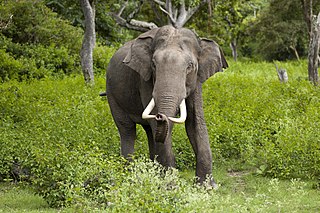
Elephantidae is a family of large, herbivorous proboscidean mammals collectively called elephants and mammoths. These are large terrestrial mammals with a snout modified into a trunk and teeth modified into tusks. Most genera and species in the family are extinct. Only two genera, Loxodonta and Elephas, are living.
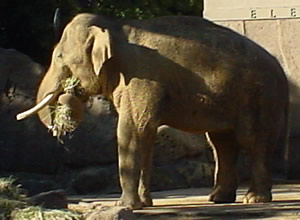
Elephas is one of two surviving genera in the family of elephants, Elephantidae, with one surviving species, the Asian elephant, Elephas maximus. Several extinct species have been identified as belonging to the genus, extending back to the Pliocene or possibly late Miocene.
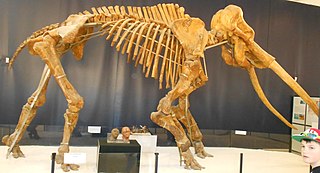
Palaeoloxodon is an extinct genus of elephant. The genus originated in Africa during the Early Pleistocene, and expanded into Eurasia at the beginning of the Middle Pleistocene. The genus contains some of the largest known species of elephants, over 4 metres (13 ft) tall at the shoulders, including the African Palaeoloxodon recki, the European straight-tusked elephant and the South Asian Palaeoloxodon namadicus. P. namadicus has been suggested to be the largest known land mammal by some authors based on extrapolation from fragmentary remains, though these estimates are highly speculative. In contrast, the genus also contains many species of dwarf elephants that evolved via insular dwarfism on islands in the Mediterranean, some only 1 metre (3.3 ft) in height, making them the smallest elephants known. The genus has a long and complex taxonomic history, and at various times, it has been considered to belong to Loxodonta or Elephas, but today is usually considered a valid and separate genus in its own right.

Stegodon is an extinct genus of proboscidean, related to elephants. It was originally assigned to the family Elephantidae along with modern elephants but is now placed in the extinct family Stegodontidae. Like elephants, Stegodon had teeth with plate-like lophs that are different from those of more primitive proboscideans like gomphotheres and mammutids. The oldest fossils of the genus are found in Late Miocene strata in Asia, likely originating from the more archaic Stegolophodon, subsequently migrating into Africa. While the genus became extinct in Africa during the Pliocene, Stegodon remained widespread in South, Southeast and East Asia until the end of the Pleistocene.

Dwarf elephants are prehistoric members of the order Proboscidea which, through the process of allopatric speciation on islands, evolved much smaller body sizes in comparison with their immediate ancestors. Dwarf elephants are an example of insular dwarfism, the phenomenon whereby large terrestrial vertebrates that colonize islands evolve dwarf forms, a phenomenon attributed to adaptation to resource-poor environments and lack of predation and competition.

Palaeoloxodon recki, often known by the synonym Elephas recki is an extinct species of elephant native to Africa and West Asia from the Pliocene or Early Pleistocene to the Middle Pleistocene. During most of its existence, the species represented the dominant elephant species in East Africa. The species is divided into five roughly chronologically successive subspecies. While the type and latest subspecies P. recki recki as well as the preceding P. recki ileretensis are widely accepted to be closely related to Eurasian Palaeoloxodon, the relationships of the other, chronologically earlier subspecies to P. recki recki and P. recki ileretensis are uncertain, with it being suggested they are unrelated and should be elevated to separate species.

The straight-tusked elephant is an extinct species of elephant that inhabited Europe and Western Asia during the Middle and Late Pleistocene. It was larger than any living elephant, with adult males suggested to reach 3.81–4.2 metres (12.5–13.8 ft) in shoulder height, and 11.3–15 tonnes in weight. Like modern elephants, the straight-tusked elephant lived in herds, flourishing during interglacial periods, when its range would extend as far north as Great Britain. Skeletons found in association with stone tools and wooden spears suggest they were scavenged and hunted by early humans, including Neanderthals. It is the ancestral species of most dwarf elephants that inhabited islands in the Mediterranean.
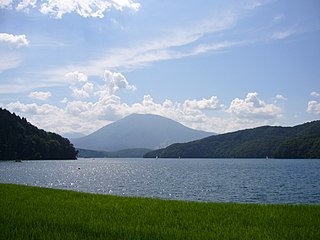
Lake Nojiri is in the town of Shinano, Kamiminochi District, Nagano Prefecture, Japan. Second to Lake Suwa among lakes in Nagano Prefecture, Nojiri is a resort, the location of the first pumped-storage hydroelectricity in Japan, and the site of a Japanese Paleolithic excavation.

Palaeoloxodon falconeri is an extinct species of dwarf elephant from the Middle Pleistocene of Sicily and Malta. It is amongst the smallest of all dwarf elephants at only 1 metre (3.3 ft) in height. A member of the genus Palaeoloxodon, it derived from a population of the mainland European straight-tusked elephant.
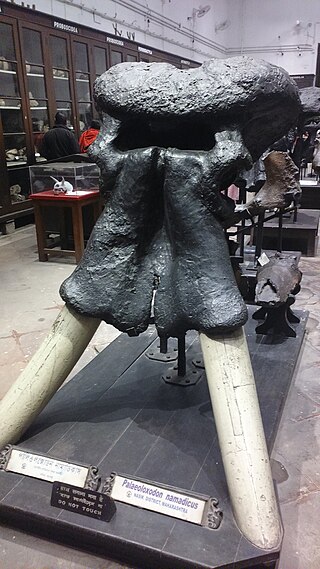
Palaeoloxodon namadicus is an extinct species of prehistoric elephant known from the early Middle to Late Pleistocene of the Indian subcontinent, and possibly also elsewhere in Asia. The species grew larger than any living elephant, and some authors have suggested it to have been the largest known land mammal based on extrapolation from fragmentary remains, though these estimates are speculative.

Palaeoloxodon cypriotes is an extinct species of dwarf elephant that inhabited the island of Cyprus during the Late Pleistocene. The species became extinct around 12,000 years ago, around the time humans first colonised Cyprus.

Elephas hysudricus is an extinct elephant species known from the Pleistocene of Asia. It is thought to be ancestral to the living Asian elephant, from which it is distinguished by the molar teeth having a lower crown height and a lower lamellae number. Remains of the species are primarily known from the Indian subcontinent, with the most important remains coming from the Siwalik Hills. The oldest remains of the species in the Siwaliks are placed at around 2.6 million year ago at the beginning of the Early Pleistocene, with the youngest dates in the Siwaliks during the Middle Pleistocene around 0.6 million years ago, though it likely persisted on the subcontinent later than this based on remains found elsewhere. Remains likely attributable to the species are also known from the Levant in Israel and Jordan, dating to the late Middle Pleistocene, likely sometime between 500-100,000 years ago. Isotopic analysis of specimens from the Indian subcontinent suggests that early members of the species were likely primarily grazers, but shifted towards mixed feeding after the arrival of the substantially larger elephant species Palaeoloxodon namadicus to the region. It is suggested to be closely related and possibly ancestral to the extinct Elephas hysudrindicus from the Pleistocene of Java in Indonesia.

Palaeoloxodon mnaidriensis is an extinct species of dwarf elephant belonging to the genus Palaeoloxodon, native to the Siculo-Maltese archipelago during the late Middle Pleistocene and Late Pleistocene. It is derived from the European mainland straight-tusked elephant.

Elephas hysudrindicus, commonly known also as the Blora elephant in Indonesia, is a species of extinct elephant from the Pleistocene of Java. It is anatomically distinct from the Asian elephant, the last remaining species of elephant under the genus Elephas. The species existed from around the end of the Early Pleistocene until the end of the Middle Pleistocene, when it was replaced by the modern Asian elephant, coexisting alongside fellow proboscidean Stegodon trigonocephalus, as well archaic humans belonging to the species Homo erectus.

Stegodon aurorae is an extinct species of Stegodon known from Early Pleistocene of Japan and possibly Taiwan. It appears to be an insular dwarf species, exhibiting smaller body size than its mainland ancestors.

Sinomegaceros is an extinct genus of deer known from the Late Pliocene/Early Pleistocene to Late Pleistocene of Central and East Asia. It is considered to be part of the group of "giant deer", with a close relationship to Megaloceros. Many members of the genus are noted for their distinctive palmate antler brow tines.
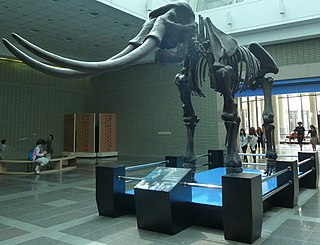
Palaeoloxodon huaihoensis is an extinct species of elephant belonging to the genus Palaeoloxodon known from the Pleistocene of China.




















